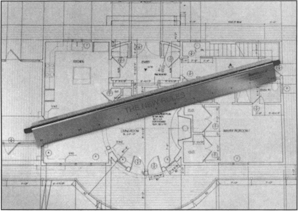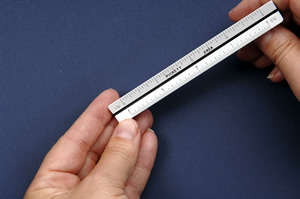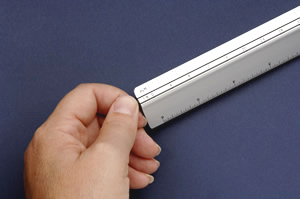Editorial Reviews

 I've never been an architect, and I'm not a carpenter anymore. But I still have occasion to use an architect's scale when I'm looking at a set of plans for an article I'm editing. The cheap scale I have is made of white plastic, and it's not very straight anymore because it sat on the dashboard of my pickup in the sun and the heat gave it a noticeable hook. I've never been an architect, and I'm not a carpenter anymore. But I still have occasion to use an architect's scale when I'm looking at a set of plans for an article I'm editing. The cheap scale I have is made of white plastic, and it's not very straight anymore because it sat on the dashboard of my pickup in the sun and the heat gave it a noticeable hook.
Because I don't design buildings for a living, there might be a trick to using a scale that I don't know about. But whenever I use a scale measure or draw I inevitably hold the wrong scale to the paper and then have to fumble with the thing, turning it end for end, turning it over, looking for the 1/4-in. scale. I'm sure that, at some time, somewhere, someone drew a set of plans using the 3/32-in. scale of the 3/16-in. scale, but I've never seen one.
Rapid Rule is a new product that solves a lot of problems. It's an aluminum ruler with a six-sided scale rod mounted on one edge. The scale rod has six different scales marked out along its length, each scale on a different side of the hexagon. You just turn the rod to find the scale you want. The rod sticks beyond both ends of the ruler, and rubber O-rings hold the scale of choice in a visible position. Unlike the aforementioned triangular architect's scale, on which some of the scales read left to right and some read right to left, all of the scales on the Rapid Rule read from left to right - the same direction you're reading this.
The edges of the Rapid Rule are raised just enough so that they won't quite touch the surface the rule is setting on. The manufacturer says the raised edges reduce ink smearing. The bottom of the ruler is concave; this concavity is also supposed to reduce smearing.
The Rapid Rule has a nice heft to it. It feels like a quality instrument. All the surfaces and edges are consistently well-finished; the numbers on the different scales are concise, and the divisions between numbers are fine and accurate. Rapid Rules are are available in six different colors, in either architectural, engineering, or metric scales and in a 6-in. version or a 12-in. version. --J.K., Fine Homebuilding.
Back to top |
 |

The standard triangular architect’s scale is a study in frustration. Not only must you flip and flop the instrument to find the scale you need, but some scales read left to right while others read right to left. The ingeniously simple design of the Rapid Rule ends this frustration because you always use it in the same position, regardless of which scale you’re reading.
The Rapid Rule looks like a standard architect’s scale that’s been squashed. The base is slightly concave so that the scale rides on its edges, sitting tightly on the paper. One of the two remaining faces has the numbered markings of a standard ruler. The other face is unnumbered and houses a six-sided scale rod. Each face of the rod is printed with a different set of scale numbers — 1/4-inch scale is on one face, the 1/2-inch scale on another, and so on — which line up with the unnumbered increment marks. To change the scale, just turn either end of the rod. Each scale always reads from left to right, and the Rapid Rule always retains the last scale you used until you purposely change it.
The Rapid Rule is made of extruded aluminum, making it more resistant to nicks than plastic scales. Three types of scales are available — architectural, engineering, and metric — and can be ordered directly from the company.
Back to top |
 |
Basic Questions and Answers about Rapid Rule.
Q: What is a Rapid Rule?
A: More than an attractive desk ruler, Rapid Rule is a special scale ruler that allows you to measure (or create) drawings of objects that are larger than the piece of paper.
Q: How does it work?
A: A rotating rod lets you select the scale or relative size represented by each inch
on the drawing, so that you can create a drawing that fits the paper, or measure a scale drawing accurately.
Q: What do the numbers on the rod represent?
A: For most drawings, the numbers refer to the number of feet represented by the drawing. However they can be any other value: yards, miles, even furlongs! You decide.
Back to questions
Back to top
Q: What do the fractions 1/4, 1/8, 1/16 on the rod mean?
A: They identify the scale in use. For instance, 1/4 usually means that 1 inch on the drawing equals 4 feet (or miles, or whatever.)
Q: How do I know which scale to use?
A: If you are reading a plan or drawing it will usually tell you in the title area, such as: 1 inch = 4 feet. If you’re creating a drawing, simply choose the scale that best fits the paper you're using and the size of the item you want to show on the paper.
Q: What makes the Rapid Rule better than ordinary triangular or flat scales?
A: You see only one scale at a time and all scales read from left to right. Once you select a scale it stays in place ready to be used the next time you pick up the rule. No flipping, flopping, or hunting for the scale you need. It's made of durable aluminum, not easily damaged plastic.
Back to questions
Back to top
Q: Why are the rod numbers upside down?
A: It depends on how you look at it! On a drawing board it is easier to have the ruler below rather than above the area you wish to measure or draw. Besides, it's traditional!
Q: Who uses Rapid Rules?
A: Architects, engineers, planners, manufacturers, installers... it's a long list but anyone who makes or reads plans or drawings that are scaled to fit a page of paper. And do-it-yourself hobbyists, of course. In short, just about everyone can use a Rapid Rule.
Q: Aren't all plans and drawings done on the computer these days?
A: Of course many drawings are now created using computers. But most computer output is still the printed page. When you're away from your desk and need to measure the plans for a building, paper works far better than a computer. For the foreseeable future, printed drawings will remain very useful, and a Rapid Rule is the best way to read and measure them.
Back to questions
Back to top
Instructions for Use of Rapid Rule Scale.
Before we tell you how easy it is to use a Rapid Rule, perhaps a word about scale rulers in general is in order. If you look at a road map, you'll see a small diagram that shows you what distance on the map represents a mile or more. This is the scale of the map, and it's needed since it would be difficult to fit the entire state of Indiana (for instance) on a single piece of paper!
The same is true for construction and manufacturing drawings or plans. You'll usually find a scale notice (often next to the name of the drawing) to indicate what distance is represented by each inch on the drawing. For instance, a typical architectural drawing might state that the scale is 1/4 which means that one inch on the plan equals four feet of actual distance. To measure any object on a scale drawing, an accurate scale rule is essential. And that's what you have with a Rapid Rule.

Take a close look at Rapid Rule's Scale Ruler. It is obvious from a glance that it is a professional quality, precision instrument. The aluminum construction is very robust. Edges are crisp and clean, and carefully polished. This rule is designed to last for years.
Using a Rapid Rule is simple. In the case of the Architectural model, one edge is a standard ruler divided into 32nds. The Engineering model ruler is divided by 50 parts of an inch while the Metric model ruler is divided by 1 mm. Since all of these models share the same design we'll use the Architectural model to discuss their use.
The other edge of the Rapid Rule's ingeniously simple design ends the confusion and frustration of typical old-fashioned "triangle" scales. You'll find one set of divisions with a small rod directly above it. Turn either end of this patented scale rod, and up to six different scales are immediately ready to use. No flipping, flopping, or hunting for the right scale edge to use. And no backwards-reading scales. Instead, you see just one scale at a time.
 |
 |
Every scale reads from left to right, and they all use the same edge divisions. Nothing could be simpler or faster to use. And note that the selected scale stays firmly in place.
No matter how often you pick up the Rapid Rule the chosen scale is always ready to use.
To use Rapid Rule scale ruler, simply glance at the drawing or plan you wish to measure, and set the scale rod to the same ratio shown on the drawing. In the case of the Architectural model you can choose between 1/16" = 1 foot, 1/8" = 1 foot, 1/4" = 1 foot, 1/2" = 1 foot, 3/16" = 1 foot, and 3/8" = 1 foot. Of course each inch on the drawing can also represent some other measure. It can stand for a yard, a mile, or even a furlong! Whatever your choice, the ratio remains the same.
If you are creating a new plan or drawing, simply select the scale that will allow the entire drawing to fit on the paper size you are using. Determine the maximum dimension to be shown on the drawing, and turn the scale rod until that maximum number fits easily on the paper. Then use the selected scale divisions just like an ordinary ruler. The Rapid Rule will automatically scale each dimension to whatever ratio you have selected. No need to figure in your head how long 19' 6" should be on your drawing, for example.
Rapid Rule has been created for long useful life and ease of use. Take a close look at the edges and the bottom of the Rapid Rule. Note the raised inking edges. These reduce ink smearing for clean, crisp lines. And the sculptured arch on the bottom of the Rapid Rule also reduces the chance of smearing fresh drawings. It even feels nice!
Each Rapid Rule is made in the U.S.A. of solid extruded aluminum. It is built to easily outlast normal plastic rules, and is much more resistant to nicking of the edges. (How many times have you had to hunt for a smooth edge just to draw a simple straight line with a plastic or wooden rule?) And this dimensionally-stable material assures that the accuracy of each Rapid Rule is maintained. Our rules are accurate to +/- 0.006" and are checked during manufacture against international standards.
There are no special precautions needed to keep your Rapid Rule in good condition. Don't use a harsh abrasive or solvents to clean it, or the markings may become harder to read! Just warm water and a clean, soft rag should be sufficient to keep it looking like new for years.
There are just four parts to a Rapid Rule. The aluminum body, the scale rod, and the two small "O" rings that hold the rod in place. If an "O" ring is lost or damaged, just drop us a line and we'll be happy to drop a new pair in the mail at once.
Thank you for selecting Rapid Rule. We're certain you'll find Rapid Rule the easiest scale you've ever used. Click here to print/view Instructions Only.
Back to top
|
